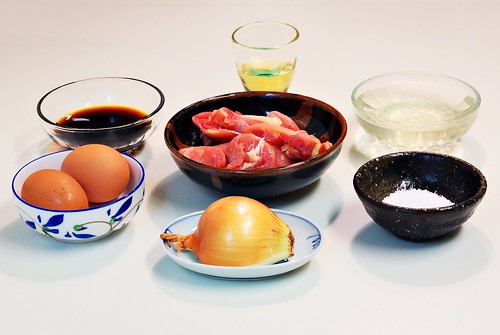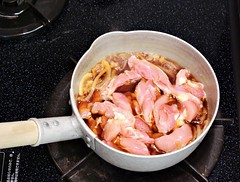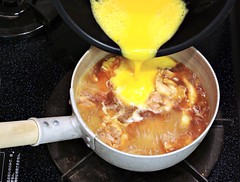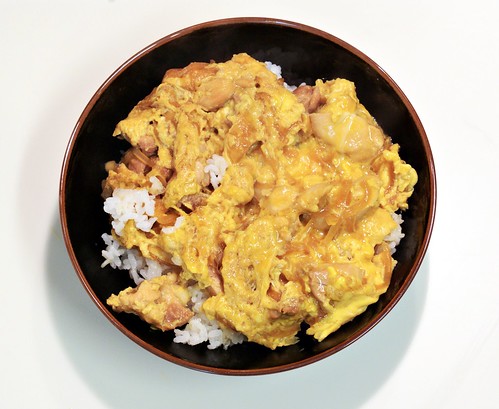Donburi (丼) is a Japanese rice dish. It means "rice bowl", and the dish is just that - a large bowl of rice with a sauce-based topping. The beauty of it is that it's all served and eaten in one bowl, making it a very convenient lunch or quick meal. If you have cooked rice already (thanks to your timer-equipped rice cooker, for instance), you can come home and have dinner finished in as little as fifteen minutes.
Oyakodon, "Mother and child bowl", is perhaps the most well known variety of these dishes. It's a topping of chicken and egg in a soy sauce broth. The name oyako (親子) comes from oya (parent) and ko (child), reflecting the use of both chicken meat and eggs. There's another variant called tanindon (他人丼), or "stranger donburi" with beef instead of chicken.
The dish is surprisingly simple to make, and with the possible exception of the soup stock all ingredients should be readily available pretty much anywhere.
| 1.5 - 2 dl | uncooked rice |
| 100 - 150g | chicken |
| 1 - 2 | eggs |
| 1 - 1.5dl | dashi |
| 0.3 - 0.5dl | soy sauce |
| 2 tbsp | mirin |
| 1 tbsp | sugar |
| 1/2 | onion |
| 5cm | leek |
The amounts are for one person; the lower end is for a normal portion, while the upper is if you're hungry and aren't going to have any side dishes.

The ingredients for Oyakodon. In the center chicken meat, then clockwise from the top mirin (sweet rice wine), dashi (soup stock - get instant dashi powder), sugar, onion, eggs and soy sauce. The leeks are missing; I forgot to buy.
For those trying to do this in Sweden, the only ingredient you'll have trouble with is the dashi (soup stock). When I last visited I did find instant dashi in one store, but it was much too expensive (almost exactly a 50-fold increase in price compared to Japan). To make your own, you need seaweed and dried katsuo flakes (which I didn't find either). The exact stock doesn't matter all that much for this dish, however. You can make a usable stock from dried mushrooms, for instance, or a thin vegetable stock. If you use ordinary stock, remember that dashi is supposed to be thin, clear and unsalted since you'll often use it with salty soy sauce. I guess you could try using vegetable stock at 1/4 strength and reduce the soy sauce a bit. I think the most important ingredient of dashi is the monosodium glutamate, so for the more chemically inclined it may be worthwhile to try using vegetable cooking water and a spoonful of MSG.
Mirin, sweet rice wine, should be available in speciality stores if nothing else. You're not using much at a time and a bottle will keep for ever, more or less, so the price is not a problem. Soy sauce is the Japanese variety which is thinner and saltier than Chinese soy.
The idea is to make a sauce, cook the chicken and onions in it, turn off the heat, then add beaten eggs and chopped leeks (which I omitted below) and carefully turn it so the egg and chicken mixture is still a little runny. The residual cooking heat should just barely set it, giving it a creamy, slightly runny consistency.


Cook the rice. Put almost all dashi, mirin, all the sugar and soy sauce in a pan and bring to a biol. Add thinly sliced onions and let them soften a bit, then add the meat. Slowly cook it until the meat is done (about ten minutes should be plenty). The sauce will reduce quite a bit; that is intentional.
While the meat is cooking whisk the eggs with the rest of the dashi (just a little bit; perhaps two tablespoons or so), a teaspoon or so of mirin and a few drops soy sauce (you don't want to darken the eggs, just give them a little saltiness). Chop the leeks, if you haven't forgotten them.
Take the pan off the heat, pour the eggs over the chicken, sprinkle leeks on top (please imagine fresh, green, dew-kissed slices of leek above), then slide the mixture on top of a bowl of rice so that the egg sort of stays on top.

Oyakodon. Unfortunately I was so busy trying to take a picture I forgot to turn off the heat. The bowl of Oyakodon is rather overcooked overcooked as a result. That I forgot to get leeks doesn't improve it either. Still very good, though.
You eat this by itself or with a couple of side dishes (miso soup, pickles, salad, tofu). It's normally served in one bowl as above, but I've seen it with rice and the mixture in separate bowls. Donburi is easy to vary; you could use tofu instead of chicken (the firm kind of tofu in that case), add moyashi (bean sprouts) or other vegetables, or skip the eggs altogether. Below is another, Chinese-inspired variant with mushrooms and carrots in a sweet and sour sauce and a few representative side dishes:


Looks lovely, I think this is going to be my dinner. Thanks for posting!
ReplyDelete